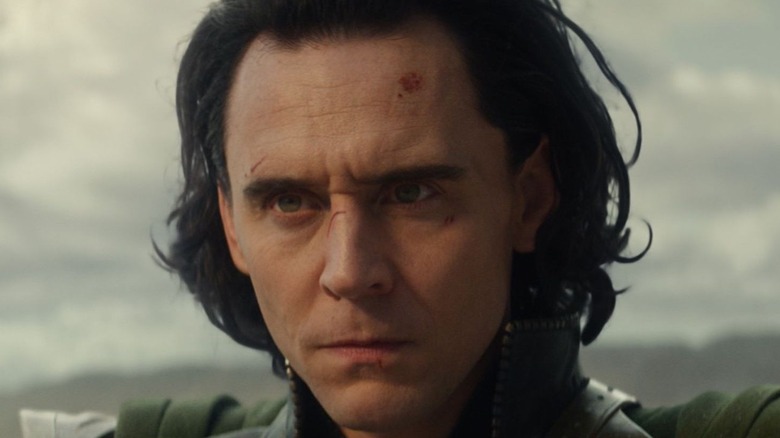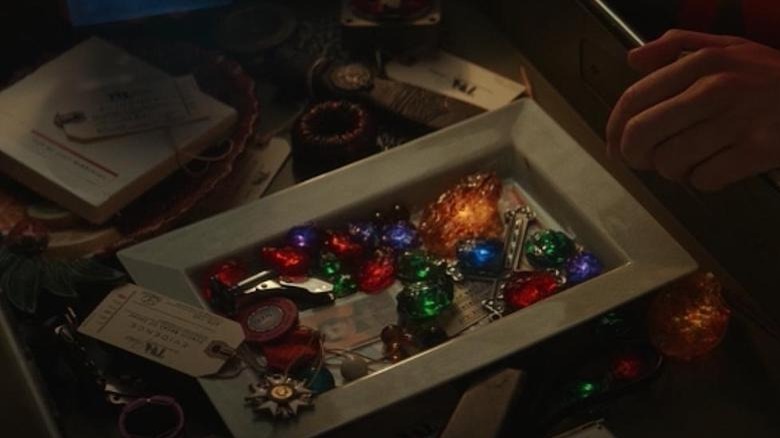The Infinity Stone Theory That Has Fans Looking Twice At Loki's Episodes
Ever since "Captain America: The First Avenger" introduced the Tesseract — aka the Cosmic Cube, aka the Space Stone — the Infinity Stones have been a vital piece of the Marvel Cinematic Universe. In years past, their existence was carefully tied with the impending arrival of the Mad Titan Thanos (Josh Brolin), who was hunting them in an attempt to create balance in the universe. Fast-forward to "Avengers: Infinity War," and audiences witnessed what happened when the intimidating villain assembled all six stones onto the Infinity Gauntlet: He snapped his fingers and killed half of all life in the universe.
Yes, in "Avengers: Endgame," the Avengers travel through time to create their own gauntlet and fix the intergalactic despot's wrongdoing, but the power of the Infinity Stones shouldn't be overlooked. Or should it? When the Disney+ series "Loki" introduced the Time Variance Authority and the existence of different timeline branches, it also revealed that the cosmic bureaucracy have a number of powerless Infinity Stones just lying around in their offices. Office worker Casey (Eugene Cordero) even quips that the TVA staff use the Stones as "paperweights."
Over 10 years of storytelling revolving around the Infinity Stones, and Marvel has seemingly made them obsolete — well, at least in the most obvious. A new theory about the Stones suggest that they do have importance within the show, and has fans looking closely at every episode of "Loki" ahead of its finale on July 14.
Some fans think each Loki episode is an Infinity Stone
A new theory on TikTok from user @She_Loves_Marvel suggests that each episode of the Disney+ series corresponds to one of the six Infinity Stones.
Now, there's a lot of legwork to be done here, as the theory heavily relies on colors used in the episodes rather than fact-based evidence, but there are some solid points. The TikTok user suggests that because "Loki" Episode 1 uses a lot of orange hues in the design of the TVA's headquarters and that it explores the God of Mischief's personality and soul, it represents the Soul Stone. See where this is going?
Meanwhile, because Episode 2 sees Loki questioning everything about the TVA since he's not sure who to trust, it signifies the Reality Stone — something further backed up by the use of red lighting later on in the episode. Episode 3 explores more of Loki and Sylvie's (Sophia Di Martino) powers and takes place on the purple moon of Lamentis-1 — so, hello, Power Stone! Moving on to Episode 4, Loki tries to change Mobius' (Owen Wilson) mind about the very nature of the TVA, and reveals that the Time Keepers aren't who they say they are. Throw in some yellow tones, and it represents the Mind Stone.
Finally, there's the brilliantly bizarre Episode 5, which properly introduces audiences to several Loki variants, like Richard E. Grant's fantastic Classic Loki. The theory-crafter argues that because Loki is being introduced to different versions of himself through time, Episode 5 represents the Time Stone. And sure, the pale green look that the Void had certainly helps.
So, by the logic of this fan theory, "Loki" Episode 6 should represent the Space Stone itself — which could work since it'll hopefully give audiences the real answers about the TVA, the Time Keepers, and the multiverse. We'll just have to wait until the episode hits Disney+ on Wednesday, July 14 to find out for certain.

